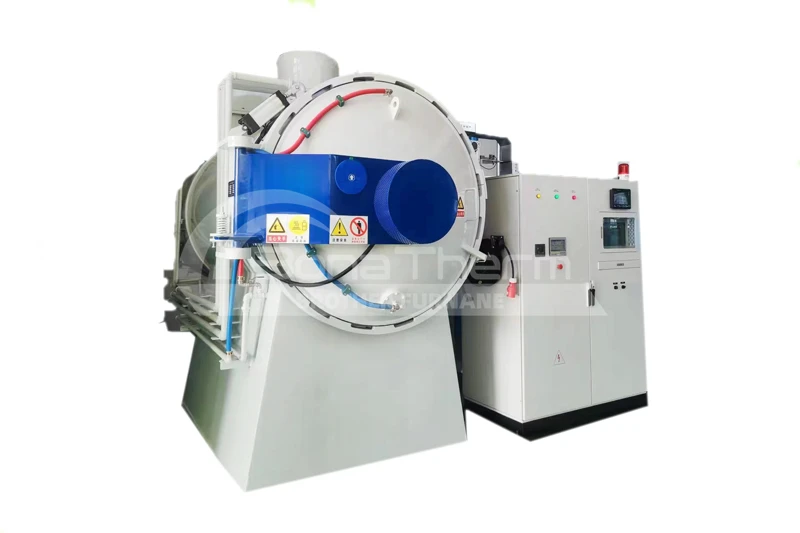seo@bonaregroup.com
Email Us

Vacuum oil quenching furnace is mainly used for bright quenching, annealing or vacuum sintering of ceramic materials and cemented carbide, such as alloy steel, tool steel, die steel, high-speed steel, bearing steel, spring steel and stainless steel; vacuum sintering of metal materials, etc.
Starting from the internal structure, we show you the unique design logic of vacuum oil quenching furnace products:

The chamber is made of graphite, and the heat shield is made of graphite felt.
Graphite tubes are used as heating elements, ensuring long life and easy maintenance.

Two-chamber structure.
The rear chamber is a heating chamber, and the front chamber is a cooling chamber, which can be used for oil quenching and air cooling. The upper part is the air quenching chamber, equipped with an air cooling system; the lower part is the oil quenching chamber, equipped with a lifting mechanism, feeding and discharging mechanisms, oil stirring device and oil heating device.

PLC automatic control system, the human-machine interface adopts high-definition touch screen, and has a built-in operating system developed by us.Programmable temperature control instrument PID adjustment.
Focusing on actual scene applications, we will highlight the advantages of vacuum oil quenching furnace equipment functions for you:
7x10-1pa.
1350℃
The lifting mechanism is driven by a three-speed gear motor outside the furnace, which drives the lifting trolley through a screw and nut. The lifting trolley has three speeds: slow speed for feeding and unloading, slow speed for starting during oil quenching, fast oil filling and slow speed for positioning.
The oil stirring system is driven by a motor reducer and a stirrer located below the feed car. The guide plate promotes the proper circulation of the vacuum quenching oil, improving the cooling capacity of the quenching oil. The stirrer is a standard part, with low noise and high efficiency.
Upper limit alarm, deviation alarm, automatic stop at the end of program operation, no need for human supervision.
Vacuum oil quenching furnaces can cover multiple fields and demonstrate their cross-industry adaptability and practical value:





Aiming at the characteristics of various materials, the core advantage of the product is its compatible processing:







Focus on answering common questions to provide users with clear and practical usage guidelines:
A:After oil quenching, the internal structure of the workpiece changes, leading to a significant increase in hardness and a notable enhancement in wear resistance, making it highly suitable for manufacturing wear-resistant parts and diverse molds.
A:It utilizes PLC automation control, enabling precise temperature and timing control according to pre-set programs. It also offers a manual operation mode for convenient commissioning and emergency response. Operators can easily master the process after simple training.
A:Oil quenching is more suitable for materials requiring high cooling rates and extreme hardness, such as bearing steel and high-speed steel. These materials require rapid subcooling to the austenite nose temperature, and oil quenching can more easily meet these requirements.
Present performance details with accurate data, intuitively showing the core technical specifications of the vacuum oil quenching furnace:
| Types | Working Zone (Width x Height x Depth)mm |
Maximum Temperature(℃) | Furnace Capacity(kgs) | Temperature Uniformity(℃) | Power(KW) | Ultimate Vacuum Degree(Pa) |
|---|---|---|---|---|---|---|
| BR-YCL-334 | 300X300X450 | 1350 | 100 | ±5 | 50 | 7x10-1 |
| BR-YCL-446 | 400X400X600 | 1350 | 200 | ±5 | 80 | 7x10-1 |
| BR-YCL-557 | 500X500X700 | 1350 | 300 | ±5 | 120 | 7x10-1 |
| BR-YCL-669 | 600X600X900 | 1350 | 500 | ±5 | 150 | 7x10-1 |
| BR-YCL-8812 | 800X800X1200 | 1350 | 900 | ±5 | 260 | 7x10-1 |
Control of all links from raw materials to finished products:
Stainless steel sheets and high-temperature-resistant alloys are selected, meeting vacuum sealing and load-bearing standards.
Cut raw materials according to design drawings using specialized equipment to ensure dimensional tolerances.
Bends and forms the sheet metal, processing the furnace shell and chamber components with a bending angle accuracy of ±1°.
Lathes are used to process precision components such as flanges and connectors, ensuring surface roughness control.
Weld the furnace body welds, ensuring airtightness on key components, and perform post-weld inspection.
Grinds and trims welded components to ensure a smooth appearance without sharp edges.
Electrostatically sprays the furnace shell and dries it.
Install the vacuum system, heating element, temperature control module, cooling system, and tighten connectors.
Conduct vacuum tests, temperature rise tests, and safety checks.
Internally cushioned with pearl cotton, externally covered with waterproof film and wooden crates, with anti-collision markings and equipment parameter labels.